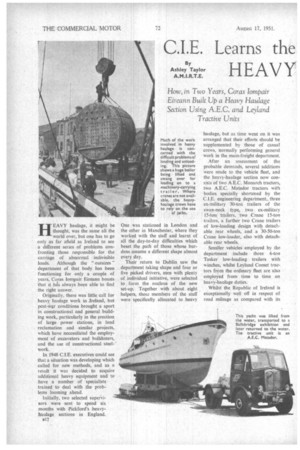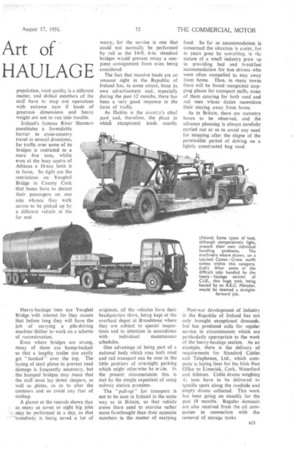CIE. Learns the Art of IIEAVY HAULAGE
Page 46

Page 47

Page 48

If you've noticed an error in this article please click here to report it so we can fix it.
By Ashley Taylor A.M.I.R.T.E.
HEAVY haulage, it might be thought, was the same all the world over, but one has to go only as far afield as Ireland to see a different series of problems confronting those responsible for the carriage of abnormal indivisible loads. Although the " outsizes " department of -that body has been functioning for only a couple of years, Cohras Iompair Eireann boasts that it .has always been able to find
the right answer. .
Originally, there was little, call for heavy haulage work in .Ireland, but post-war conditions brought a spurt in constructional and general building work, particularly in the erection of large power stations, in land reclamation and similar projects, which have necessitated the employment of excavators and bulldozers, and the use of constructional steelwork.
In 1948 C.I.E. executives could see that a situation was developing which called for new methods, and as a result it was decided to acquire additional heavy equipment and to have a number of specialists trained to deal with the problems looming ahead.
Initially, two selected supervisors were sent to spend six • months with Pickford's heavyhaulage sections in England.
1312 One was stationed in London and the other in Manchester, where they worked with the staff and learnt of all the day-to-day difficulties which beset the path of those whose burdens assume a different shape almost every day.
Their return to Dublin saw the department taking shape and four or five picked drivers, men with plenty of individual initiative, were selected to form the nucleus of the new set-up. Together with about eight helpers, these members of the staff were specifically allocated to heavy haulage, but as time went on it was arranged that their efforts should be supplemented by those of casual crews, normally performing general work in the main-freight department.
After an assessment of the probable demands, several additions were made to the vehicle fleet, and the heavy-haulage section now consists of two A.E.C. Monarch tractors, two A.E.C. Matador tractors with bodies specially shortened by the C.I.E. engineering department,, three ex-military 30-ton trailers of the swan-neck type, two ex-military 15-ton trailers, two Crane 15-ton trailers, a further two Crane trailers of low-loading design with detachable rear wheels, and a 30-50-ton Crane low-loader, also with detachable rear wheels.
Smaller vehicles employed by the department include three 6-ton Tasker low-loading trailers with winches, whilst Leyland Comet tractors from the ordinary fleet are also employed from time to time on heavy-haulage duties.
Whilst the Republic of Ireland is exceptionally well off in respect of road mileage as compared with its population, road quality is a different matter, and skilled members of the staff have to map out operations with extreme care if loads of generous dimensions and heavy weight are not to run into trouble.
Ireland's famous River Shannon constitutes a formidable barrier to cross-country travel in several directions, for traffic over some of its bridges is restricted to a mere five tons, whilst even at the busy centre of Athlone a 10-ton limit is in force, • So tight are the restrictions on Youghal Bridge in County Cork that buses have to decant their passengers on one side whence they walk -across to be picked up by a different vehicle at the far end.
Heavy-haulage `men eye Youghal Bridge with interest for they reason that before long they will have the job of carrying a pile-driving machine thither to work on a scheme of reconstruction.
Even where bridges are strong, many of them are hump-backed so that a lengthy trailer can easily get " hooked" over the top. The laying of steel plates to prevent road damage is frequently necessary, but the humped bridges may mean that the staff must lay down sleepers, as well as plates, SO as to alter the contours and so avoid any fear of mishap.
A glance at the records shows that as many as seven or eight big jobs may be performed in a day, so that somebody is being saved a lot of
worry, for the service is one that could not normally be performed by rail as the I4-ft. 6-in, standard bridges would prevent many a onepiece consignment from even being considered.
The fact that massive loads are an unusual sight in the Republic of Ireland has, to some extent, been its own advertisement and,, especially during the past 12 months, there has been a very good response in the form of traffic.
As Dublin is the country's chief port and, therefore, the place in which exceptional loads usually originate, all the vehicles have their headquarters there, being kept at the overhaul depot at Broadstone where they are subject to special inspections and to attention in accordance with individual maintenance schedules.
One advantage of being part of a national body which runs both road and rail transport can be seen in the little problem of overnight parking which might otherwise be ar ute. to the present circumstances this is met by the simple, expedient of using railway station premises.
The "pull-up" for transport is not to be seen in Ireland in the same way as in Britain, so that vehicle crews there need to exercise rather more forethought than their opposite numbers in the matter of carrying
food. So far as accommodation is concerned the situation ;s easier, for in years gone by something in the nature of a small industry grew up in providing bed and breakfast accommodation for bus drivers who were often compelled to stay away from home. Thus, in many towns there will be found recognized stopping places for transport staffs, some of them catering for both road and rail men whose duties necessitate their staying away_ from home.
As in Britain, there are statutory hours to be observed, and the advance planning is always carefully carried out so as to avoid any need for stopping after the elapse of the permissible period of driving on a lightly constructed bog road.
Post-war development of industry in the Republic of Ireland has not only brought exceptional demands, but has produced calls for regular service in circumstances which are particularly appropriate to the work of the heavy-haulage section. As an example, there is the delivery of requirements for Standard Cables and Telephones, Ltd., which company is laying lines for the Irish Post Office to Limerick, Cork, Waterford and Athlone. Cable drums weighing 4!, tons have to be delivered in specific spots along the roadside and empty drums collected. This work has been going on steadily for the past 18 months. Regular demands are also received from the oil companies in connection with the removal of storage tanks.
The task of peat cutting has always been visualized as a primitive affair, as in fact it often is. But under !lord Na Mona, the turf development organization, big machines are being employed to simplify the work, outstanding amongst these being a 180ton giant which is specially intended to speed up hog drainage and so expedite fuel production for the electricity organization. To simplify carriage, this is divided up into sections weighing 20-40 tons each. One of the biggest individual jobs carried out was the transport of a 481-ton cast-steel cylinder for Killeen Paper Mills near Dublin_ This cylinder had to be moved by night because the police foresaw considerable congestion being caused were it to travel during the daytime. Although the distance involved was only about four miles, this was one of those cases where bridge trouble occurred, and it was only by droppinthe springs that a quarter-inch clearance was secured to enable the load to clear one of the principal railway arches in the city.
Whilst the 100-ton crane at North Wall docks could be used for loading from the ship, on arrival at the destination the heavy-haulage section was entirely responsible for offloading by means of jacks. Perhaps an even trickier problem was that concerned with the raising of a 28-ton boiler 8 ft_ above ground-level and placing it on piers.
Another interesting lifting and haulage job was that in which a yacht, purchased by its owner in Holland and sailed from Amsterdam, was lifted from the water at North Wall and carried by a bogie trailer to be put on exhibition on the Hospitals' Trust ground at Ballsbridge. After 14 days on show, the boat was returned to the water, afterwards being sailed by a new owner to America.
Pile driving machinery, 80-ft. girders and aircraft are among the abnormal and indivisible load§ that have been successfully handled. Contractors and quarry owners have availed themselves of the services of this enterprising section of CIE., which has taken so vital a share in the readjustment of Irish industry to the bolder outlines of post-war development.




















































































